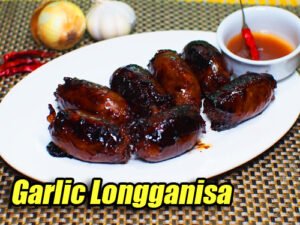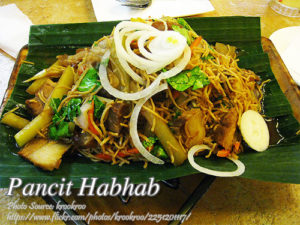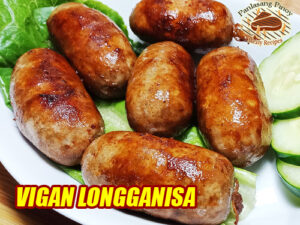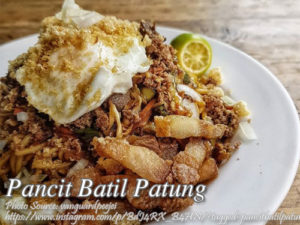This Chinese sausage or longaniza Macau recipe is a popular ingredient in making pancit bihon and other Filipino dishes that has a Chinese influence. You can easily identify it because it has lots of cubed fat inside the casing and they are very dry and oily.
You can buy it in wet markets in the dry good sections or in a supermarket already packed and ready to cook. They are more expensive than an ordinary longanisa but you can save money by making your own longaniza macau. The recipe I have here includes a sauce if you want to eat the chorizo on it’s own. It’s like a salad dish that you can enjoy.
Longaniza Macau: Memories From the Kitchen Window
When I was a kid, my Lolo Ernesto always kept a few strings of longaniza hanging near the kitchen window. I used to wonder why he didn’t put them in the fridge like the rest of our food, and he would just laugh and say, “Para matuyo. That’s how the flavor comes out.” It wasn’t until years later—when I started making my own longaniza macau—that I finally understood what he meant. Drying doesn’t just preserve the sausage, it deepens the flavor, giving it that salty-sweet aroma that fills the house every time it hits a hot pan.
A Taste of Two Worlds
Longaniza macau, or Chinese chorizo as some call it, is one of those ingredients that bridge Filipino and Chinese cooking. You’ll see it peeking out from a plate of pancit bihon or tossed with fried rice at breakfast. Its origins trace back to Chinese traders who brought cured sausages to the Philippines centuries ago. Over time, Filipino cooks adapted the recipe—adjusting the sweetness, using local vinegar, and even playing with the ratio of fat to meat. The result is something distinctly ours, yet still carrying a hint of its Chinese roots.
When my cousin Marivic visited from Binondo, she brought along a pack of authentic Chinese sausages from Ongpin. We compared them side by side with the homemade ones my uncle made in Batangas. The difference? The homemade longaniza macau had a softer sweetness and a bolder garlic note—less wine, more warmth. It tasted like home.
Why Make It at Home?
You can easily find this sausage in wet markets or supermarkets, usually hanging in the dry goods section. They’re pricier than your everyday longanisa, and for good reason—the curing process takes time, and the ingredients are top quality. But making your own longaniza macau at home lets you control the flavor and save money while you’re at it.
My Tita Mila taught me a trick: always mix your seasonings first before adding them to the ground pork and cubed fat. This way, every bite of sausage gets the same balanced flavor—salty, sweet, and a little bit smoky. It’s the kind of small step that makes a big difference, especially for beginners still learning how to handle cured meats.
The Secret Is in the Drying
Once you’ve mixed and stuffed your sausage into casings, patience becomes your best friend. Store it in the refrigerator for three days before cooking. This resting time allows the flavors to meld and the curing to start. On the fourth day, boil the sausages gently in water, pricking them once or twice with a fork. My uncle used to say this step “lets the air out,” which is true—pricking prevents the casing from bursting and helps the fat render evenly.
After simmering, the next step is drying. Traditionally, you’d hang the sausages under the sun, letting the natural heat do its work. The warm air slowly pulls out moisture while the fat settles inside, giving the longaniza its signature glossy look. If you don’t have space to hang them outdoors (and many of us don’t these days), you can use a low oven—about 200°F—for two hours. The gentle heat mimics sun drying and produces the same chewy, flavorful result.
Serving and Enjoying the Longaniza Macau
You can store your longaniza macau in the fridge or hang it in a cool, dry place if you plan to use it soon. It keeps well and tastes even better over time, as the seasonings mature. When I was in college, I’d slice a few pieces, fry them until the fat turned golden and crisp, then toss them into leftover rice. Instant comfort food!
For those who want to enjoy it as a dish on its own, try making a simple sauce. Mix soy sauce, vinegar, sugar, and a bit of minced garlic, then pour it over thinly sliced sausage. My brother Nestor likes to add chopped siling labuyo for extra heat, turning it into a tangy-sweet-salty “salad” that pairs beautifully with hot rice.
A Slice of History, A Taste of Home
What I love most about this dish isn’t just its taste—it’s how it tells a story. Every region, every household, has its version of this cured sausage. Some are redder, some sweeter, some leaner. But at its heart, longaniza macau captures the Filipino knack for adaptation: taking something foreign and making it our own.
Whenever I cook it now, the smell always takes me back to my grandparents’ house—the open windows, the clatter of pans, and the slow rhythm of home cooking. It’s more than just food; it’s a memory you can taste.
So the next time you see those shiny, fat-speckled links hanging in the market, don’t just walk by. Bring some home, or better yet, make your own. You’ll understand why this humble Chinese chorizo has stayed a beloved part of our kitchens for generations.
How to Make Longaniza Macau
Ingredients
- 1 kilo lean ground pork
- 1/4 kilo pork fat cubed
- 1/4 tsp. salitre
- 2 Tbsp. white sugar
- 2 Tbsp. fine salt
- 2 Tbsp. anisado wine
- 1/4 tsp. red food coloring
- longganisa casing
Sauce for longaniza Macau
- 2 Tbsp vinegar
- 2 Tbsp. sugar
- 1 onion sliced thinly
- dash of pepper
Instructions
How To Make Longaniza Macau
- Mix all seasoning before adding to ground pork and fat. Mix well, then fill in casings. Store in refrigerator for 3 days.
- On the 4th day, place longaniza in pan, cover with water and boil. While boiling prick once or twice with a fork to eliminate air bubbles in longaniza. Simmer until it dries.
- Hang and dry under the sun or place in oven with a low heat (200°F) for 2 hours or until it dries.
- Store in a refrigerator or hang on a dry place.
To make the sauce
- Mix all the sauce ingredients. Pour over thinly sliced longaniza and serve.
Notes
Cooking Tips:
Mix the Seasonings Thoroughly
Before adding your spices to the meat, mix all the seasonings in a separate bowl. This ensures every bit of pork and fat gets the same balance of sweetness, saltiness, and umami. Even flavoring is key to achieving that signature longaniza macau taste in every bite.Prick the Sausage While Boiling
When boiling the sausages, gently prick them with a fork once or twice. This helps release trapped air and excess fat, keeping the casing from bursting. It also allows the longaniza to cook evenly and develop a firmer, juicier texture.Dry It Low and Slow
Whether sun-drying or using an oven, keep the temperature low and allow the longaniza macau to dry gradually. This slow process enhances the flavor and helps preserve the sausage naturally. Rushing the drying stage can make the meat tough and unevenly cured.






Leave a Reply